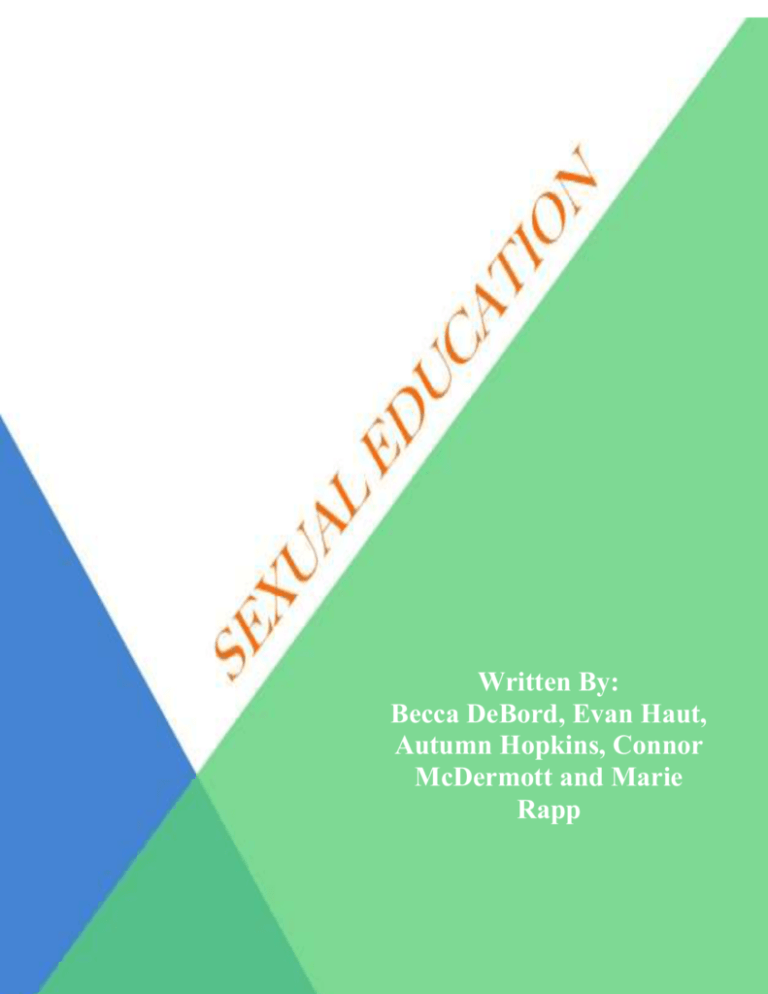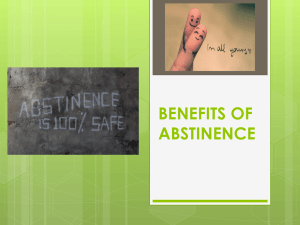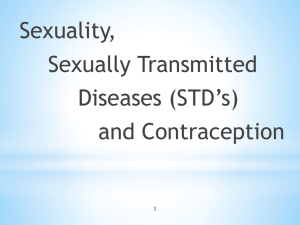
Written By:
Becca DeBord, Evan Haut,
Autumn Hopkins, Connor
McDermott and Marie
Rapp
2
Table of Contents
Introduction
Pg. 3
How and Why Sexual Education is Taught
Pg. 4-10
What Current Scholarship is Saying
Pg. 10-2
How We Would Teach Sexual Education
Pg. 13-5
Our Experiences with Sexual Education
Pg. 16-9
Conclusion
Pg. 20
Works Cited
Pg. 21-2
Introduction
3
The role of sexual education in student’s lives is essential.
Without sex ed., students would not receive the information
needed to understand their bodies and functions. This paper will
discuss how and why sexual education is taught, what current
scholarship is saying on the topic, how we would teach sexual
education and our own experiences with sexual education.
How and Why Sexual Education is Taught
There are two main curriculums for how sexual education is taught.
The first is that sexual education should not be in depth and that schools
4
should just push students to be completely sexually abstinent. The second
view is to teach everything students need to know about the topic, and teach
safe sex instead of abstinence.
Teaching abstinence is favored by many government officials and
politicians simply because it is “safe”, which means less controversy for
them. Government officials also favor abstinence because they believe that if
we teach kids not to have sex, the odds of them getting STDs and becoming
pregnant drops significantly. There are many government programs to help
teens with children. If fewer teens become pregnant, the government has to
spend less money funding these programs (Stranger-Hall and Hall 10).
According to an article in Education Digest Journal written by Del Stover,
Politicians and Parents like to go the safe route. Stover writes:
On its face, abstinence education isn't controversial. Who is going to
argue against telling kids to hold off on sexual activity? Public
opinion polls show Americans overwhelmingly in favor of schools
delivering that message. And lawmakers are listening. At least 27
states now have policies stressing abstinence in sex education courses,
and 14 more mandates that abstinence be taught. (Stover 42)
Many politicians will agree that teaching abstinence is the way to go. And
they think that having the students learn about contraceptives and being safe
5
would make the students think it is okay to be sexually active. Sexual
activity isn’t necessarily the biggest problem in the eyes of the government,
after all the age of consent in Ohio is sixteen. The biggest problem is
however the students that contract STDs or become pregnant. Many officials
believe that the students will think that sex is okay without the contraceptive,
if they are taught through the contraceptive method (Sex Education in
Schools 546). Stover writes:
Advocates for this model are sharply critical of "comprehensive" sex
education, arguing that discussions about contraception, sexual
orientation, or other controversial topics can encourage sexual
experimentation by sending students mixed signals about what's
expected of them. (Stover 42)
Obviously parents want their children to stay abstinent for as long as
possible but some think that not letting the students learn about it will hurt
them more than help them.
For supporters of the abstinence only education curriculum they
believe they are protecting their children and the youth of the nation by
helping set certain morals for the student. Without teaching about
contraceptives and “safe sex” they believe that they are showing students
that by no means are they supporting sex before marriage because they think
6
if those things are taught then they are showing the students that they
promote sexual activities before marriage.
An example of an abstinence based curriculum:
(Wiley, Wilson)
Supporters of the fully teaching sexual education say that ignoring and
pretending something is not there is worse than just giving students the
information. Many people actually believe that doing this raises STD rates
7
along with teen pregnancy rates. Raising the rates for these two is
completely counterproductive for the program. The whole reason for the
program in the first place is to lower these two rates in teens. Many believe
that an abstinence-based education leaves out too much information, causing
the children to figure things out for themselves (Stranger-Hall and Hall 6).
According to an article in The Journal for Social Justice written by
Katherine Carrol:
Advocates for comprehensive sex education focus on sex education
curricula and programs as a means to address a number of health
issue, not limited to those surrounding sexual intercourse. These
curricula stress the importance and value in abstinence while
acknowledging the reality that not all teens will remain abstinent until
marriage. Contrary to what abstinence only proponents would have
the public believe, these complimentary goals represent the
cornerstone of comprehensive sex education curricula. The Sexuality
Information and Education Council of the United States (“SIECUS”)
has crated sample curricula for kindergarten through the twelfth
grades, all with the underlying goal of addressing the following in age
appropriate manner: sexual development, reproductive health,
interpersonal relationships, affection, intimacy, body image, and
8
gender roles. SIECUS advocates that these goals can be best achieved
through the following four guiding principles: (1) provide “accurate
information about human sexuality”; (2) create a place for students to
develop and understand their “values, attitudes and beliefs about
sexuality”; (3) aid young people in the development of their
“relationship and interpersonal skills”; and (4)”help young people
exercise responsibility regarding sexual relationships, including
addressing abstinence, pressures to become prematurely involved in
sexual intercourse, and the use of contraception and other sexual
health measures. (Carrol 44-5)
There is a very large debate on which curriculum should be taught and
because it is such a sensitive subject there will most likely never be a
resolution.
Although there is one resolution that many parents would favor,
schools could teach both curriculums. Every teen should be taught about the
dangers of sex. Now, for the second portion, the inclusive portion, students
could be put into study hall if their parents are uncomfortable with their
children learning the information. Now the information could also be taught
through an abstinent light, meaning they tell you all of the ways to be
contraceptive however remind students throughout the session that they
9
should remain abstinent. This way the children can receive the education
that the government decides is best, but also the parents can choose whether
or not their children receive the information on contraceptive. However, it is
important to allow parents to have this choice. This gives parents who don’t
know the information or know incorrect information, the opportunity to have
their child gain the knowledge in the traditional school setting.
What Current Scholarship is Saying
Sexual education is a highly debated topic. There has been much research
and many studies on the effectiveness of the class. One researcher, Netsanet
Fentahun states that:
Sex education is education about human sexual anatomy, sexual
reproduction, sexual intercourse, reproductive health, emotional
relations, reproductive rights and responsibilities, abstinence,
contraception, family planning, body image, sexual orientation, sexual
pleasure, values, decision making, communication, dating,
relationships, sexually transmitted infections STIs) and how to avoid
them, and birth control methods. (Fentahun 99)
10
Many researchers and scholars take a close look at Sexual Education and
how it’s being taught.
Scientists and researchers have agreed upon the importance of
teaching sexual education. It has reached the point that many students,
teachers, and parents have seen the importance of teaching it. In one article it
states, “Ninety seven percent of the students appear to have positive attitudes
towards the importance of school sex education…ninety nine percent of the
teachers seem to have positive attitude towards the importance (of sex ed.)”
(Fentahun 104). Scholars are finding that our modern society is becoming
more open to the idea of teaching younger kids sex ed. Kids need to know
about sex to protect them and keep them out of harm. In an article by Juliette
Goldman, the authors express several supportive points as to why sex
education is beneficial for student’s protection from teen pregnancy, rape
and sexually transmitted diseases. Goldman comes to the conclusion that it
is best for the students to learn this information at a younger age to protect
themselves for their future.
There becomes much debate about when the teaching of sexual
education should start. Many scientists and researchers come to the
conclusion that it should begin at a much earlier age due to the trends in
modern society. Research done on students and teachers say that, “The
11
minimum and maximum introduction time for school sex education is 5
years and 25 years” (Fentahun 105). Which is stating that sex ed. should
begin being taught in elementary school, where in most places, isn’t taught
till late middle school and into high school. Along with these topics, sexual
education is a great way for young children to learn about puberty and all of
the changes their bodies will go through and why.
How A Scholarships is Furthering Sexual Education
It is very rare for someone to receive a scholarship for the topic of sex
education. There are scholarships that have to do with sex education in some
type of way. Sex Education has an impact on the Tony DeBlase scholarship.
What is the Tony DeBlase scholarship?
The Tony DeBlase Scholarship supports students who want to enter the
fields of sex education, sex therapy, research, or furthering the
understanding of human sexuality and alternative sexuality. There is not a
specific GPA requirement to get accepted into the Tony DeBlase
scholarship. In the past this scholarship has had applicants ranging from the
age of sixteen to sixty five.
How We Would Teach Sexual Education
12
Around the time a student is in junior high, at the seventh and eighth
grade levels, when teens typically begin going through puberty. This is a
great time to begin addressing the topic of sex and how the body matures.
This because it’s such a new change for one to go through and that
explaining it at an early age can be beneficial to how that student deals with
preteen and teenage years.
While everyone’s body is different, some may develop faster than
others, but knowing what to expect will better prepare the child for what the
natural process is going to bring.
On the teaching method of this matter, every school uses different
resources as to how they present the matter of sex-ed. While books do a
sufficient job at explaining and defining what forms of contraception are
available, what the girls and boys both go through during puberty, and some
consequences of un-safe sex, such as sexually transmitted diseases and
possible teen pregnancy, can all be explained well through text. However,
some hands-on methods of teaching also benefit students with better means
to understanding how to take care of themselves.
Much responsibility needs to be taken into consideration when
making the decision to become sexually active. Without being aware of how
to use condoms, when to take birth control, or the judgment of picking a
13
partner in which you become sexually active with, could be harmful to that
person in the long run and have negative effects on their lives. Teen
pregnancy is preventable as long as common sense is used, and this common
sense is learned, luckily, at a young age with the subject of sex-ed. Without
the countless number of videos, statistics and facts learned in this class,
young people could be at a much higher risk of becoming parents early, or
even have the burden of contracting a sexually transmitted disease.
While some parents may be opposed to schools educating their child
on sex and puberty, it’s a factual and conventional way for one to learn the
majority of what they need to know to be well aware of their sexual
behaviors and decision-making. Goldman, Juliette D.G., and Graham L.
Bradley also address the increasing popularity of sex-education on the
Internet, self-sex education, and those resources provided, which are also
found to be beneficial. In society today, the topic of sex is apparent
everywhere, whether it be on television, the radio, books, religious settings,
or even overhearing one’s conversation discussing sex. This may lead
children to wonder or have the wrong impression of what sex really is or
how it should be handled. (Goldman, Graham 2-3)
With educating that child correctly about sex, they can have a more
realistic understanding on this topic. However, some factors to the ways this
14
subject is taught have been found to be able to make the learning more
effective. In a study conducted by Fentahun, Netsanet, et al, they explain
that, “the age, sex of teachers, trained and experienced teachers in teaching
sex education have more positive attitudes towards the importance of school
sex education.” (Goldman, Graham 2) This is logical because having a
teacher try to correctly explain a subject they aren’t qualified to do would
not be helpful to those students in the class.
I completely support the idea of sex education being taught in school,
at the level it is now. All in all, continuing sex education seems to be
working well for the most part with young children, and can only be
beneficial to that student. It may seem like a touchy subject that parents
might not want their son or daughter to be exposed to at the age of 12, 13 or
14, but the earlier this natural way of life is addressed, the better they will be
able to make a responsible decision when deciding to have sex.
Our Experiences With Sexual Education
Becca’s Experience:
My sex ed. in high school, it was simply called health. My school had
the comprehensive sexual education approach where we didn’t just learn
15
about abstinence. We mostly just learned about the human body and how it
functioned. The most memorable thing about my sex ed. class, we each had
to do a detailed in depth project on an STD of our choice. We had to include
pictures and symptoms and causes. I think it was to scare us into thinking if
we ever had sex we would get an STD.
Marie’s Experience:
Almost all students go through a sex education or health class in high
school or middle school. Middle school sex education was most of the basic
things like drugs, and a few STD’s. I remember receiving the candy “Now
and Later’s,” and being told the choices you make now will affect you later.
Once I got to high school sex education classes got more important and
mature. I learned everything from drugs, STD’s, and sex, to even watching
childbirth on the TV in class. The childbirth was traumatizing for some, as
one of the students in my class passed out while watching it. Throughout all
the sex education classes that I have attended they have all been co-ed,
which made it awkward for many students. Ultimately, I learned many
things in my sex education classes that would have been terrible learning
from my parents. I feel that sex ed. classes in school are very important not
only for the students, but also the parents.
16
Evan’s Experience:
My sex education experience in middle school was extremely
awkward. We had met in the health room and were kept boys and girls
together in the room. They explained to our class how the miracle of life
works. They started with how to impregnate a woman and moved through
the stages of pregnancy and through the birthing process. They mostly
discussed how condoms were ineffective and that they often don’t work.
They talked shortly about sexually transmitted diseases. Most of the time
however was talking about reasons not to have sex. They never discussed
proper birth control use.
Then again freshman year we had an assembly to discuss
sexually transmitted diseases. We were broken up by gender and met in the
auditorium separately. We were shown pictures of infected and diseased
bodies and they were used to scare us from having sex. We were never
talked to about proper birth control use. The rest of my class was
unfortunately extremely immature about the whole thing and they ended the
assembly early due to the constant interruption and bursts of laughter. These
assemblies happened once a week for the rest of my high school education.
The crowd became less and less disruptive as we got older.
17
Then when I took health class as a junior in high school we devoted
two full weeks of class to sex education. Some of the days were about things
like how to care for an infant. Some of the other things discussed in health
were sexually transmitted diseases again. My teacher had a very strong
Christian presence in the classroom. We were told that condoms were only
84% effective against HIV, but that was an ineffective rate. We were told
that he was not permitted to teach us proper condom use or birth control use,
because the school board wanted abstinence only taught in the classrooms.
Autumn’s Experience:
In seventh grade, I was required to take a health class in my needed
curriculum, which we learned about puberty, sex, as well as the essentials to
know how to give our bodies appropriate nutrients to function. My class, as
most health classes are, was separate with all girls, in which a female teacher
taught us. The boys had a male teacher, this made it easier to take the class
more seriously, and the atmosphere was more comfortable to talk about any
questions we may have had. I also had to take health again in high school,
which went more in-depth about sex and appropriate usage of birth control
and condoms. I felt that I knew what was being taught to me, but being able
18
to have a teacher explain the topic of sex and other body image topics made
my venture through high school easier.
Connor’s Experience:
I had three experiences with the idea of sexual education. Once was in
middle school during seventh grade. From what I can remember they mainly
taught the idea of abstinence. Than when I entered high school I was taught
sexual education two separate times. Once was just health class, where they
went into complete detail of anything and everything. Than another time, the
school had a group come in and talk to us about the different diseases and
STDs.
Conclusion
In conclusion, sexual education plays an extremely important role in
student’s development. When a student is taught strictly abstinence they
miss vital material needed to mature correctly. Without sex ed., students
would not receive the information needed to understand their bodies and
functions.
19
Works Cited
Carrol, Katherine. "Children's Lives As A Political Battleground: The
Plague Of Abstinence Only Education." DePaul Journal For Social
Justice 3.1 (2009): 41-77. Web. 19 Nov. 2013.
Fentahun, Netsanet, et al. "Parents' Perception, Students' And Teachers'
Attitude Towards School Sex Education." Ethiopian Journal of
Health Sciences 22.2 (2012): 99-106.. Web. 10 Nov. 2013.
Goldman, Juliette D.G., and Graham L. Bradley. "Sexuality Education
20
Across The Lifecycle In The New Millennium." Sex Education 1.3
(2001): 197. Web. 9 Nov. 2013.
"Pride Foundation." Pride Foundation LGBTQ Community Foundation.
Web. 25 Nov. 2013.
"Sex Education in Schools. (Cover Story)." Georgetown Journal of Gender
& The Law 10.2 (2009): 533-552. Web. 18 Nov. 2013
Stover, Del. "Should We Be Teaching Sex Education Or Sexual
Abstinence?." Education Digest 72.5 (2007): 41-8 Web. 11 Nov.
2013.
Stranger-Hall, Kathrin F, and David W. Hall. "Anstinence-Only Education
and Teen Pregnancy Rates: 'Why We Need Comprehensive Sex
Education in the U.S." Plos ONE 6.10 (2011):1-11. Web. 18 Nov.
2013
Wiley, DC, and KL Wilson. "Influence Of Materials On Teacher Adoption
Of Abstinence-Only-Until-Marriage Programs." Journal Of School
Health 79.12 (2009): 565-74. CINAHL. Web. 19 Nov. 2013.








